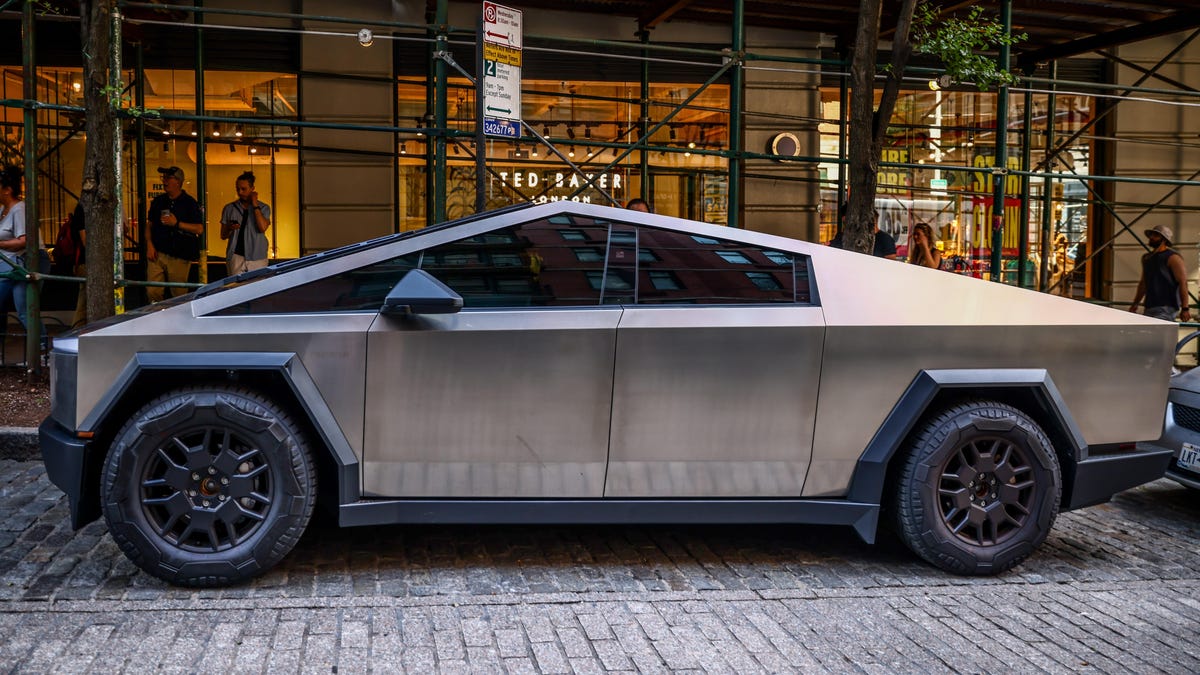The Tesla Cybertruck is very much illegal in Europe, but that hasn’t stopped a lightly modified version of Elon Musk’s pickup from making it over there. There’s currently at least one Cybertruck driving around cities in the Czech Republic, and people are worried – especially because it probably isn’t going to pass a single safety test the Europeans can throw at it.
The European New Car Assessment Program hasn’t gotten its hands on the Cybertruck yet to see how its passengers and the people it hits would survive in a crash, but it’s already looking like the truck would door poorly based on an eye test alone, according to Wired. Euro NCAP’s director of strategic development, Matthew Avery, said that based solely on the Cybertruck’s appearance, “there are several aspects of this vehicle that look like they may be a threat to pedestrians.” Yeah, bud, you think?
Here’s a look at how Europe’s safety standards differ from the U.S., and why that’s a bad thing for vehicles like the Cybertruck. From Wired:
Until recently there has been a woeful lack of focus in the US on similar pedestrian protection from automobiles. Earlier this month, however, the National Highway Traffic Safety Administration (NHTSA) unveiled the first rule that would limit the risk of pedestrian head injuries in a collision.
Europe’s tougher regulations make for safer cars, for those inside and out. Designed to test how safe a car is in a crash, Euro NCAP instantly cut through automakers’ safety claims with rigorous independent testing, hard facts, and an easy-to-understand five-star rating system.
It’s hard to sell a car in the EU with anything less than a four- or five-star rating. Nevertheless, even vehicles that score zero can go on sale and be perfectly legal to buy.
[…]
[I]t takes a particular kind of customer to buy a car knowing it has a low-star safety rating for the occupants and potential Mad-Max-style lethality to those outside the vehicle. The kind of customer who would buy a Cybertruck?
An open letter from a group of European transport nongovernmental organizations said the Cybertruck was far too bulky and sharp to be allowed on European roads, saying, “the approval and registration of Cybertrucks in the EU poses illegal risks to all over road users.” Tough words, but they’re probably right. Here’s more of the letter, from Wired:
“The small number of Cybertrucks registered so far in the EU need to be de-registered, with the relevant Member States confirming their removal from public roads,” continues the letter, signed by the leaders of, among others, the European Transport Safety Council, the International Federation of Pedestrians, and the European Cyclists’ Federation.
“Very oversized pickup trucks [are] now being increasingly imported and bringing danger to our streets,” warned James Nix of the nonprofit Transport & Environment, one of the other organizations that signed the open letter, which cites the US consumer advocacy nonprofit group Center for Auto Safety’s conclusion that compares the EV’s potential to harm pedestrians to “a guided missile.”
One of the main issues the Cybertruck’s design faces in Europe is the fact EU motor directives prohibit sharp edges on cars – something the Cybertruck has a ton of. The folks who imported one into the Czech Republic got around this by fitting incredibly thing rubber pads to the corners in a crude attempt to blunt the edges.
This issue was brought up in the NGO’s letter, saying Czech authorities required “ultra-narrow” rubber slats to be retrofitted to the truck. Still, even with the slight modification, Cybertruck doesn’t meet EU rules that prohibit sharp edges in the first place.
Weight and “type approval” are also big issues for the Cybertruck in Europe, as Wired explains:
The EU motor directives also require speed limiters on vehicles that weigh more than 3.5 metric tons when full. Tesla’s manual lists the steel vehicle as having a gross vehicle weight of 4 metric tons.
[…]
EU type approval means confirmation that production samples of design meet specified performance standards set by the European Commission’s automotive directives.
Imported cars can be registered through an “individual vehicle approval” that subjects them to less scrutiny than a standard type approval. Member State approval authorities, responsible for checking motor vehicles before they go on sale, have wiggle room to deviate from EU rules in individual cases if they impose alternative requirements.
In the open letter, the NGOs said that the owner-importer of the Czech Cybertruck attempted to classify it as a light-duty vehicle under EU law – something it technically isn’t:
The letter asks the Czech transport ministry to point to a legal basis allowing the maximum weight of the vehicle, as declared by the vehicle maker and imprinted on the Vehicle Identification Number (VIN) plate, to be disregarded in favor of a figure approximately half a ton less, thereby conveniently matching the EU weight limit for light-duty vehicles.
“Were we to see mass private importation or something that gets around type approval we may consider a one-off [testing of a Cybertruck],” says Avery.


